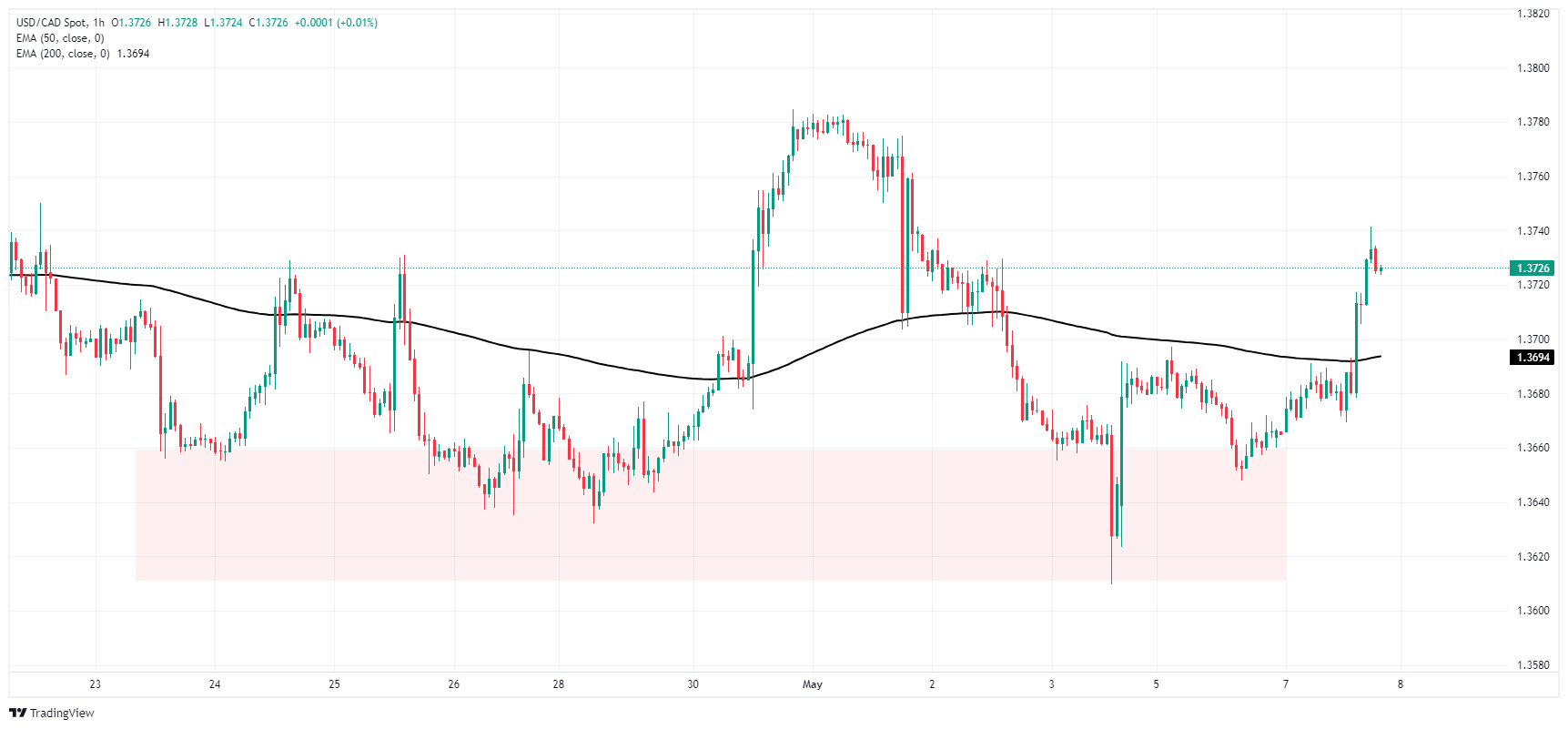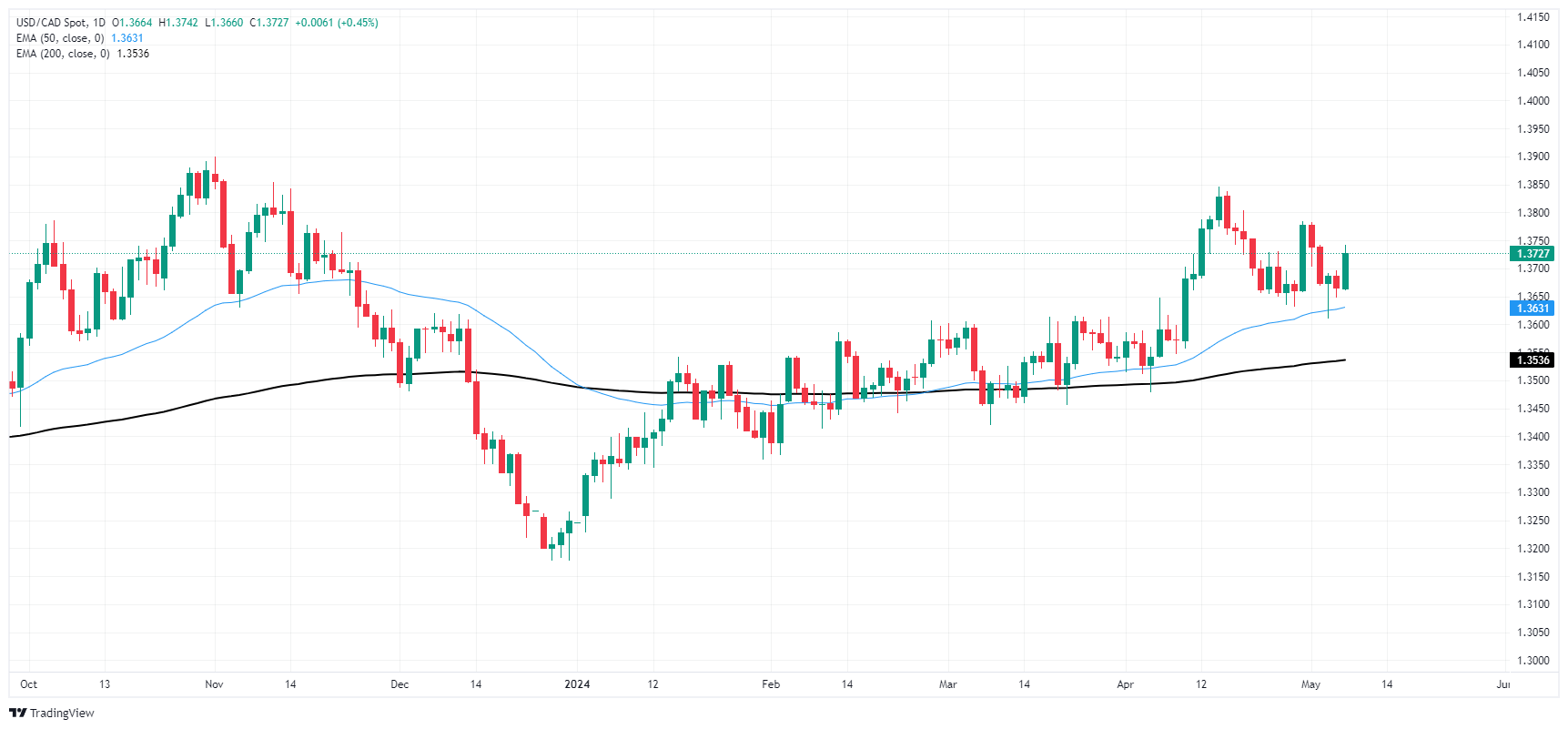Canadian Dollar backslides on Tuesday despite upbeat Ivey PMI
- Canadian Dollar easing but sticking to midrange.
- Canada Ivey PMI beat expectations in April.
- CAD markets wait for Friday’s Canadian labor data.
The Canadian Dollar (CAD) was broadly softer on Tuesday but stuck close to near-term technical levels as CAD markets shrugged off better-than-expected Ivey Purchasing Managers Index (PMI) figures from Canada. Markets await soundbites from Federal Reserve (Fed) policymakers as investors broadly focus on the Fed’s rate cut outlook.
Canada saw an improvement in the seasonally-adjusted Ivey PMI for April, signaling that business leaders in both the private and public sectors of Canada’s economy see an improvement in overall business activity. However, battered Crude Oil markets and floundering barrel prices limit the CAD’s ability to find higher ground.
Daily digest market movers: Upbeat Canadian PMIs fail to spark bullish interest
- Canada’s seasonally-adjusted Ivey PMI for April improved to 63.0 from 57.5, beating the forecast of 58.1.
- April’s Ivey PMI hit a two-year high, printing its highest activity survey result since May of 2022.
- Broader markets continue to focus on Fedspeak as investors hope for signs of rate cuts from the Fed.
- Thursday’s Financial System Review from the Bank of Canada (BoC) is widely expected to produce market moves.
- CAD traders looking out for Friday’s Canadian Net Change in Employment and Unemployment Rate numbers.
- Canada’s Net Change in Employment forecast to add net 20K jobs in April after the previous month’s -2.2K decline.
- The Canadian Unemployment Rate is expected to have increased to 6.2% in April, up slightly from the previous month’s 6.1%.
- Risk appetite on Tuesday was soured after Minneapolis Fed President Neel Kashkari threw cold water on rate cut hopes, noting that inflation and a tight labor market remain key points that lock the Fed out of rate cuts.
- Fed's Kashkari: Fed will hold rates where they are if we need to
Canadian Dollar price today
The table below shows the percentage change of Canadian Dollar (CAD) against listed major currencies today. Canadian Dollar was the weakest against the US Dollar.
| USD | EUR | GBP | CAD | AUD | JPY | NZD | CHF | |
| USD | 0.11% | 0.39% | 0.43% | 0.47% | 0.28% | 0.17% | 0.22% | |
| EUR | -0.12% | 0.27% | 0.32% | 0.37% | 0.18% | 0.04% | 0.12% | |
| GBP | -0.40% | -0.28% | 0.05% | 0.10% | -0.09% | -0.22% | -0.14% | |
| CAD | -0.44% | -0.31% | -0.04% | 0.06% | -0.12% | -0.27% | -0.19% | |
| AUD | -0.48% | -0.38% | -0.10% | -0.06% | -0.18% | -0.33% | -0.25% | |
| JPY | -0.28% | -0.18% | 0.08% | 0.11% | 0.17% | -0.14% | -0.04% | |
| NZD | -0.15% | -0.04% | 0.23% | 0.28% | 0.33% | 0.15% | 0.09% | |
| CHF | -0.26% | -0.15% | 0.13% | 0.17% | 0.23% | 0.04% | -0.10% |
The heat map shows percentage changes of major currencies against each other. The base currency is picked from the left column, while the quote currency is picked from the top row. For example, if you pick the Euro from the left column and move along the horizontal line to the Japanese Yen, the percentage change displayed in the box will represent EUR (base)/JPY (quote).
Technical analysis: Canadian Dollar stubbornly swims in familiar circles
The Canadian Dollar (CAD) is broadly softer on Tuesday, giving up most of Monday’s early gains to trade into familiar bids. The CAD is flat to down across the board, shedding around a third of a percent against the New Zealand Dollar (NZD) and the Euro (EUR). The CAD is also down nearly half of a percent against the US Dollar (USD).
USD/CAD broke through the 1.3700 handle on Tuesday with the CAD shrugging off Monday’s slim gains. The pair cracked through the 200-hour Exponential Moving Average (EMA) at 1.3697, and the Canadian Dollar has shed all of the gains found after last Friday’s US Nonfarm Payrolls (NFP) print dragged the pair down to 1.3610.
Daily candlesticks show USD/CAD finding near-term technical support from the 50-day EMA at 1.3629, with long-term bullish pressure from the 200-day EMA at 1.3552. The pair is still down from mid-April’s peak near 1.3850, but USD/CAD is still trading higher for the year, up 3.4% from January’s opening bids near 1.3250.
USD/CAD hourly chart
USD/CAD daily chart
Canadian Dollar FAQs
The key factors driving the Canadian Dollar (CAD) are the level of interest rates set by the Bank of Canada (BoC), the price of Oil, Canada’s largest export, the health of its economy, inflation and the Trade Balance, which is the difference between the value of Canada’s exports versus its imports. Other factors include market sentiment – whether investors are taking on more risky assets (risk-on) or seeking safe-havens (risk-off) – with risk-on being CAD-positive. As its largest trading partner, the health of the US economy is also a key factor influencing the Canadian Dollar.
The Bank of Canada (BoC) has a significant influence on the Canadian Dollar by setting the level of interest rates that banks can lend to one another. This influences the level of interest rates for everyone. The main goal of the BoC is to maintain inflation at 1-3% by adjusting interest rates up or down. Relatively higher interest rates tend to be positive for the CAD. The Bank of Canada can also use quantitative easing and tightening to influence credit conditions, with the former CAD-negative and the latter CAD-positive.
The price of Oil is a key factor impacting the value of the Canadian Dollar. Petroleum is Canada’s biggest export, so Oil price tends to have an immediate impact on the CAD value. Generally, if Oil price rises CAD also goes up, as aggregate demand for the currency increases. The opposite is the case if the price of Oil falls. Higher Oil prices also tend to result in a greater likelihood of a positive Trade Balance, which is also supportive of the CAD.
While inflation had always traditionally been thought of as a negative factor for a currency since it lowers the value of money, the opposite has actually been the case in modern times with the relaxation of cross-border capital controls. Higher inflation tends to lead central banks to put up interest rates which attracts more capital inflows from global investors seeking a lucrative place to keep their money. This increases demand for the local currency, which in Canada’s case is the Canadian Dollar.
Macroeconomic data releases gauge the health of the economy and can have an impact on the Canadian Dollar. Indicators such as GDP, Manufacturing and Services PMIs, employment, and consumer sentiment surveys can all influence the direction of the CAD. A strong economy is good for the Canadian Dollar. Not only does it attract more foreign investment but it may encourage the Bank of Canada to put up interest rates, leading to a stronger currency. If economic data is weak, however, the CAD is likely to fall.